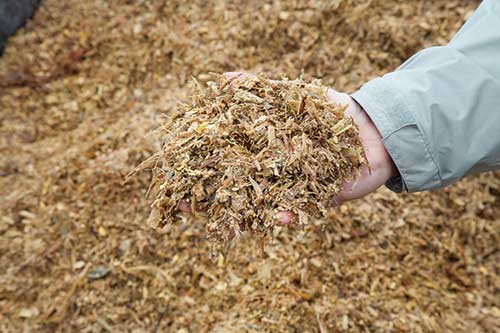
How often do you remember opening the shop refrigerator and finding moldy or spoiled food tucked away in the back?
I vividly recall grabbing a half gallon of milk from the fridge, drinking from the jug and turning immediately to spew the contents on the floor because the milk had soured and curdled. That’s a bad memory everyone would like to wipe from their brain.
Similar, yet different, how intensely do you recall a spoiled forage situation and the resulting herd health challenge?
For example, have you ever experienced feeding spoiled feed and then having cattle digestive tracts upset or showing signs of bloody gut? Such a recall may make you, too, sick to your stomach, but you won’t forget it.
What causes food or forage to spoil?
It all starts with exposing good food, or silage, to air. Then wild yeast and mold (both are fungi), and negative bacterial species (such as Clostridium spp.), cause the deterioration. Where do the anti-nutritional microbes that spoil food or forage come from?
Spoilage microorganisms and their spores are literally everywhere! Microbial spawn exists in large numbers in the soil, on the harvested forage, living or dormant in silage and surviving in cattle digestive tracts. In some cases, the negative microbial species can even vastly outnumber the beneficial bacteria in bacterial inoculants.
Different farms, regions and growing conditions also vary wildly, much like different shop refrigerators. For example, farms that irrigate with lagoon or “gray” water, or that fertilize with manure over growing alfalfa, could be inoculating growing plants with trillions and trillions of challenging bacteria or fungi. These bacteria and fungi can be controlled by two primary ensiling facets: limiting oxygen exposure (creating an anaerobic environment) and driving the forage pH to less than 4 to 4.5. This process must be quick, controlled and create an aggressive fermentation environment. The net effect is similar to putting food into the freezer — as opposed to the refrigerator — because bacteria and mold can’t grow.
But as eluded to, many silos, bags, bunkers and pits are not efficiently preserved. Silage is not effectively stored in an anaerobic environment and/or lowered to less than 4.5 pH in a short time frame (days). Hence, spoilage ensues just like in that milk jug.
The downward quality slide
There are two different loss and spoilage paths with fermented feed:
Path 1 — forage spoils and endures substantial shrink during initial fermentation; via secondary fermentation
Path 2 — forage spoils and shrinks at feedout when silage is re-exposed to air
During spoilage Path 1, if oxygen is not kept out of the silo or the forage pH does not fall, the challenging microorganisms will grow after the initial fermentation stops. During this second fermentation, Clostridia spp. and other organisms will begin to grow, sometimes breaking down lactic acid and leading to a higher silage pH, which is far from desirable.
Then, as pH creeps above 5.0, other negative organisms can grow. Forage shrink happens (up to 30 percent losses) as these negative bacteria grow and consume usable nutrients meant for cows. The consequences of negative bacteria breakdown include butyric acid, broken down proteins (rendering them unusable) and a litany of other anti-nutrition factors.
During spoilage Path 2, fermented and preserved forage is re-exposed to air, and previously dormant yeast begin growing using sugars and acid as fuel. Similar to Path 1, pH rises as acid is metabolized by yeast. As pH values climb, mold and other aerobic bacteria can grow much like what happens when leaving food out on the counter for days. This is also an unhealthy situation that includes nutrient losses. If not pitched out, the actively growing micro flora will inoculate the nutritious TMR, causing rumen health challenges.
There is also a fascinating, but challenging, merging of the two spoilage paths. Oxygen and air can penetrate 3 to 5 feet into even a well-managed silage face if not fed aggressively enough. In this case, Path 1 (anaerobic spoilage) deterioration can restart in the presence of Path 2 (aerobic spoilage), where yeast grow so aggressively all of the oxygen 3 feet deep in the silage is used and an anaerobic environment reforms in the forage. In this case, the challenges associated with both Path 1 and Path 2 spoilage events have the opportunity to emerge.
Hidden investigative opportunities
Consider evaluating the following silage health to uncover potential animal performance gains. This also reduces or stops nutrition depletion in feed.
Common silage health indicators:
1. Mold and yeast counts
- The aim is less than 1,000 CFU per gram of forage
2. Mold species identification
- Depending on mold identification, anaerobic (or field) versus anaerobic challenges can be identified
3. Mycotoxin identification
- Similar to mold, field born versus fermentation born challenges can be categorized by identifying the present toxins
4. Silage alcohol(s) – these can be intake limiting factors; ideally, very little alcohol should be present (less than 0.5 percent)
- Ethanol
- Other alcohol compounds
More advanced silage health evaluation:
Enterobacteria counts (negative bacteria found in many silages)
- Clostridium spp.
- Lysteria monocytogenes
- Salmonella typhimurium and Enterococcus faecalis
In all three cases, “clean” forage will have less than 100 to 200 CFU per gram of forage.
Future areas of focus:
- Biogenic amines
- Ethyl-lactate
Avoid feed and health challenges
Ultimately, the keys to healthy feed include controlled fermentation, proper harvest-time dry matters, eliminating oxygen and dropping forage pH fast at ensiling. Harvest high-quality feed, with adequate sugar, to drive fermentation. Consider a research-proven bacterial inoculant, acid or food-grade preservative to keep nutrient robbing organisms at bay. Pack and seal forage as quickly as reasonably possible, and avoid extended fill situations.
At feedout, discard visibly spoiled feed and the forage immediately around it. Situations occur where the visibly spoiled feed is actually stable again, albeit robbed of nutrients, and active deterioration is taking place all around the spoilage, 50 percent or greater in size of the spoiled feed.









